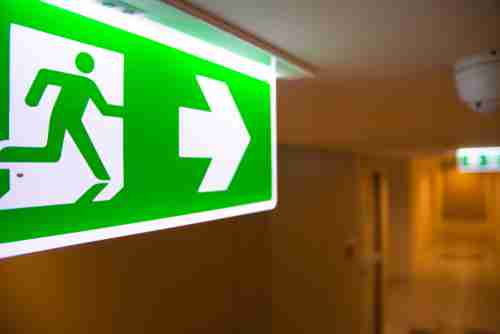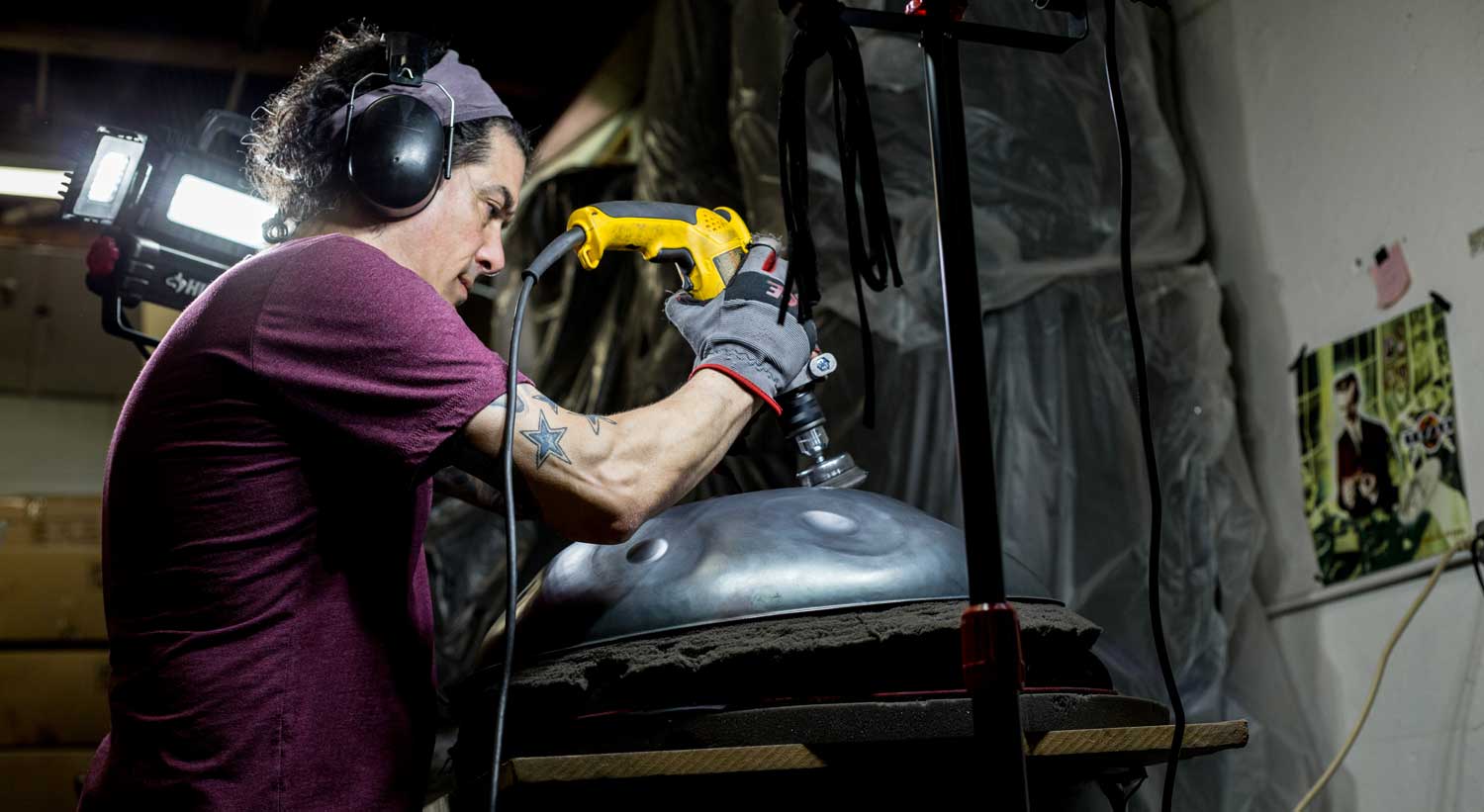Importance of Emergency and Exit Lighting in Your Building
Would your building be prepared in the event of a power outage? Just as seatbelts and airbags must be working properly in case of a car accident, so should alarms, extinguishers and other equipment during a fire, power outage or other disaster. However, one of the most broadly applicable – and therefore one of the foremost – life safety solutions that often goes unnoticed is emergency and exit lighting.

The U.S. experiences a higher number of long-lasting power outages than any other developed country in the world. The average U.S. power customer loses power for 3.5 hours per year, whereas in Japan the average customer experiences only six minutes of power loss each year.
When outages occur, occupants may not have confidence navigating buildings safely. Areas such as stairwells, internal offices, restrooms, storage areas and other spaces with little or no natural light can be especially difficult to navigate without functional emergency lighting, but these aren’t the only areas of concern.
Related: Beef Up Business Continuity Planning
To help protect those inside a facility, installing and maintaining emergency and exit lighting is important.
The Power of Light
A 2017 Harris Poll of 2,072 U.S. adults ages 18 and older found that more than a third (34 percent) of U.S. workers would lack confidence in their ability to navigate their workplace safely in the event of a power outage. More specifically, if a workplace power outage occurred, 50 percent of U.S. adults would lack confidence in their ability to walk up and down stairways safely.
Additionally, 42 percent would not be confident in their ability to calmly execute their workplaces’ emergency plan.
The results of the poll show that people regard lighting as an important safety resource when a building goes dark. Emergency lighting helps people to see clearly, avoid obstacles, locate equipment and navigate effectively throughout a building during a power outage.
Facility managers should prepare buildings for unexpected events like power outages, whether the outage is caused by a fire, severe weather, faulty power grid equipment or another unpredictable issue.
Lighting the Way to Safety
Despite the importance of emergency and exit lighting, it is often overlooked once these devices have been installed within a facility. If these units don’t function when they’re needed most, building visitors and occupants are left in the dark.
Property owners and managers are responsible for scheduling and/or performing maintenance of their illuminated emergency exit signs and lights. Best practices for maintenance include:
Visually inspecting equipment on a regular basis. Look for loose or exposed wiring and make sure it is secure. Ensure that units are mounted to the wall or ceiling securely.
Look for loose or exposed wiring and make sure it is secure. Ensure that units are mounted to the wall or ceiling securely.
Conducting regular inspections. Depending on the jurisdiction, emergency and exit lighting must undergo a functional test every month . These tests are designed to check for physical damage to the exterior of the lights and to help verify that the lights are functional at the time of the test.
Depending on the jurisdiction, emergency and exit lighting must undergo a . These tests are designed to check for physical damage to the exterior of the lights and to help verify that the lights are functional at the time of the test.
Conducting a full functional test. Depending on the jurisdiction, organizations may be required to ensure lights function under battery power for an extended period. Follow required testing procedures and check to ensure all lights remain lit under DC power. Repair or replace units that don’t function correctly for the duration of the test.
Depending on the jurisdiction, organizations may be required to ensure lights function under battery power for an extended period. Follow required testing procedures and check to ensure all lights remain lit under DC power. Repair or replace units that don’t function correctly for the duration of the test.
Maintaining diligent records of inspection. Written records of inspection tests should be kept by the building owner for review by the Authority Having Jurisdiction (AHJ). Any lights that were not able to be tested should also be documented by location, including the reason a test could not be completed.
Emergency and Exit Lighting: A Bright Solution
Power outages occur more frequently in the U.S. than many building owners and managers realize. The five-year annual average of reported outages doubled every five years from 2000 to 2014 – meaning the 2014 annual average is four times what it was 15 years ago.
Installing and properly maintaining emergency and exit lighting will help provide occupants a way to safely exit a building or navigate to an area to seek shelter in the event of an emergency. Outsourcing equipment testing, inspection and repair to an experienced provider can help simplify the process and help you satisfy applicable local standards.
On topic: Are You Testing Emergency Lighting?
When it comes to building safety, functioning emergency lights are important – and organizations should prioritize them, along with other elements of their life safety system.
Taylor Brummel is a marketing manager with Cintas Corporation, a leader in fire protection products and services. To learn more about emergency and exit lighting, visit
Two hand-picked articles to read next:
Why Emergency and Exit Lighting is Important in Fire Systems
When it comes to security advice, one of the most important areas has to be fire safety. This is because lives can be saved courtesy of the right guidance and fire security systems. Here our London security experts are looking at the importance of emergency and exit lighting in fire safety systems, complete with advice on where it’s needed, and the different types of lighting available.

What is the law on emergency escape lighting
The Regulatory Reform (Fire Safety) Order 2005 makes anyone in charge of commercial premises and the common areas of a House in Multiple Occupation (HMO) responsible for the safety of everyone who works, visits or lives in the building. This duty of care includes the provision of emergency lighting.
The legal requirement is that non-domestic buildings must be safe at all times, including in the event that mains power failure occurs. For this reason, almost all such buildings must have emergency lighting fitted.
What is the purpose of emergency lighting?
Fire security systems London wide need to incorporate emergency lighting because it can literally save lives. It is designed to make sure that in the event of the normal power supply failing, illumination is provided promptly, automatically and for sufficient time. This will ensure that occupants of a building are able to evacuate safely in the event of an emergency, such as a fire.
When a fire alarm sounds without warning, and fire starts to spread throughout a building, a sense of panic will often ensue. If the building is plunged into darkness, which is often the case during a fire, disorientation and confusion can arise, increasing the risk of injury, and making it all the more difficult for occupants to find their way out.
A clear escape route signalled by lights however, makes it more straightforward to exit the building safely during a fire.
Emergency escape lighting is designed to illuminate escape routes such as corridors and stairways, as well as the location of fire-fighting equipment such as fire extinguishers, together with security equipment such as key boxes that house emergency keys to exit doors.
What are the legal requirements for emergency lighting?
It is essential that any emergency lighting system is well-designed and adequately planned out in order to protect lives.
In legal terms, the light needs to stay on for one full hour following the main power outage. Where sleeping accommodation is concerned, for example in an HMO, this increases to three hours.
What are the different types of emergency lighting?
There are a various types of fire escape and exit lighting. The most traditional type consists of internal and external bulkhead emergency fittings which are connected to the main electrical wiring. These will usually operate for three hours without any mains power, for example when cables burn through, and will recharge when the mains power has been restored.
LED emergency lighting is becoming increasingly popular due to its energy saving advantages. Battery packs kick in automatically in the event of a power cut.
Illuminated fire exit signs are another type of emergency lighting. These light up to show the location of fire exits.
Photoluminescent marker tape, paint and floor discs are also used to mark escape routes. They are especially useful where there are changes of level in a building, for example stairwells and uneven floors. These markings can be particularly effective when people need to escape through smoke, and for those who are partially-sighted.
What is the difference between maintained and non-maintained emergency lighting?
Maintained emergency light fittings can be operated with a switch. They can be left permanently on, or set to operate in the event of a power cut. Maintained lights are mostly used where groups of people meet, for example, in a cinema. They are designed to prevent total darkness, with the emergency lights able to function even in a power cut.
Non-maintained fittings will not illuminate unless there is a power cut. This type of emergency lighting is often powered by battery, which can charge itself through its own power supply.
Any type of emergency lighting requires regular testing to ensure it meets current, relevant safety requirements.
Where is emergency escape lighting needed?
Each individual building will have its own particular requirements when it comes to emergency illumination. Even within a building, the needs will vary from one part to another. Some areas for example will benefit from natural light, whereas others will have a constant need for artificial light.
For buildings occupied during the night, emergency lighting will usually be required in all areas, including those that benefit from natural light during the day. Exceptions may be where ‘borrowed’ light from the likes of external street lamps will suffice, providing the light source is reliable, and the occupants of the building are familiar with its layout.
In summary, emergency escape lighting will usually be required to cover the following:
All individual exit doors
Escape routes
Corridor intersections
Outside each final exit and on external escape routes
Emergency escape signs
Stairways and where there are changes in floor levels
Windowless rooms and toilet accommodation exceeding 8m²
Fire-fighting equipment
Fire alarm call points
Equipment that would need to be shut down in an emergency
Lifts
Areas in premises greater than 60m²
Whilst it is not a requirement to provide individual lights for each of these items, there does need to be a sufficient level of overall light to make them visible and usable.
Expert fire security advice from Barry Bros Security
When it comes to fire security systems London businesses know they can trust Barry Bros Security for expert advice, long term experience and tailored guidance, and that includes on emergency escape lighting.
To discuss the fire safety requirements for your individual building, you are welcome to get in touch with our helpful specialists.
Why is emergency lighting so important?
Why is emergency lighting so important?

Whether you’re entering an office, retail shop, cinema, restaurant or any commercial setting, you’re bound to have noticed the very visible and obvious emergency lighting systems in place around the exits of that building. It is mandatory that you install emergency lighting in your premises according to British Standard 5266-1. This states that all hospitals, schools, offices, shops and multi-story buildings must install and maintain a minimum standard of emergency lighting systems.
Despite the apparently obvious safety benefits to emergency lighting, there was a time when emergency lighting systems didn’t exist and the risk of fire-related accidents in public and private premises was significantly higher. This raises the question, why is emergency lighting so important?
It keeps us safe
The glaringly obvious answer is that it keeps us safe. When the power in your building fails (and it isn’t unlikely as it sounds), how will the occupants find their way around safely? Emergency lighting will be running in your building 24/7, without the need for your main power source. Not only will emergency lighting illuminate the exits in case of an emergency, but they’ll also prioritise popular areas in the building that are used on route to an exit. Exit emergency lights are also useful for guiding occupants in case of an emergency. Even if lighting is still available, an exit light will help send occupants in the right direction to safety.
Saves your business money
If you have an unexpected outage in your office, work floor or shop, emergency lighting can help you and your employees to resume work in an orderly fashion whilst the source of your power is restored. In doing so, you can reduce downtime at work and effectively save yourself money on potential non-productivity during work hours.
It’s compliant
Having emergency lighting isn’t really a choice. You need it to be compliant with current British Standards of health and safety in the workplace. Unless you want governmental officials knocking on your door with a clipboard, we suggest that you install a system that complies with regulations swiftly.
What types of emergency lighting are there?
How much do you know about the different types of emergency lighting units available? Whilst they all serve the purpose, there are units that function in different ways.
Maintained
This unit works just like a normal light however when the main power fails, this unit will switch to a battery-powered output and run from there until the main power is switched back on.
Non-Maintained
This unit will only turn on when the main lighting system fails due to a power outage. This unit is only powered by the main power supply for charging purposes.
Combined emergency lights
The combined units comprise of two different lights in the unit. One of those lights is powered by the normal power supply on a day-to-day basis whilst the emergency light within the unit is powered by the backup energy supply. This system can be ‘maintained’ or ‘non-maintained’ depending on the circumstances.
Do you need emergency lights installed or maintaining?
As NICEIC approved electrical contractors, you can count on Fire & Electrical to do a professional job that meets current legislative health and safety requirements. If you’re in need of emergency light installation or maintenance, do not hesitate to contact us on 01908 564301 or email us on


![31 Best IPTV Services for FireStick, Android TV, PC [Dec 2021]](https://www.lampsofbible.com/storage/upload/Images/_1639646173_nXrO23JGnM.jpg)





